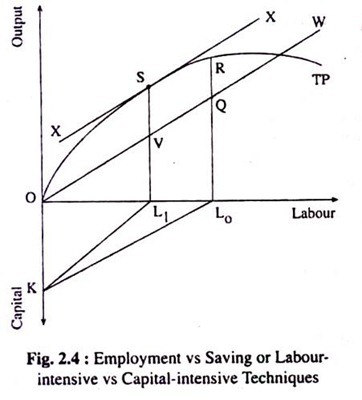The Conflict between Employment and Saving!
Another area of conflict centers around employment and saving. This is the issue of maximisation of employment at the cost of saving. If maximisation of employment of a technology is given priority, it will reduce both output and investible surplus.
The reason is simple enough: If we assume that wage rate is given and invariant with respect to the technique of production, the more labour-intensive the technique, the less saving is likely to be generated for reinvestment in the future.
Since marginal propensity to consume (MPC) of workers is higher than the capital owners, the total surplus or saving and the surplus per unit of capital invested left for re-investment will be smaller under labour-intensive technology. Conversely, the more capital-intensive the technology, the lower the level of present consumption and employment, but higher the future rate of investment, growth, and employment.
ADVERTISEMENTS:
This argument may again be illustrated in terms of Fig. 2.4 used by M. Dobb and Amartya Sen. The amount of capital, OK, is assumed to be given and is measured on the vertical axis below the origin. This amount of fixed capital is combined with varying units of labour measured on the horizontal axis to produce output. Output is measured on the vertical axis above the origin. TP is the output curve which exhibits diminishing returns to labour. The line OW shows the volume of wage bill. At a fixed wage rate the wage bill proportionally increases with the quantity of variable input, labour.
The difference between the TP curve and OW line measures profit or surplus. Profit or surplus or saving is maximised where a line drawn parallel to the OW line is tangential to the TP curve, i.e., point S. That is, when OL1, amount of labour, is combined with OK fixed volume of capital, then reinvested surplus, SV, becomes the greatest.
However, if the employment of labour is increased the volume of surplus will be smaller—the volume of saving and investible surplus RQ is smaller when OL1, the amount of labour is employed. Thus, the more labor-intensive techniques maximise output and consumption in the short run, but the more capital-intensive techniques provide a greater surplus for reinvestment for growth and future output and consumption.
ADVERTISEMENTS:
The upshot of the current discussion on the choice of techniques is that it is not possible to make an invariable choice in favour of more labour- intensive techniques even in overpopulated countries, unless we make explicit choice between the present and the future. The more we value raising the present consumption level and current employment against future growth, the more we should go for labour-intensive techniques. On the contrary, capital-intensive technology should be favoured.
